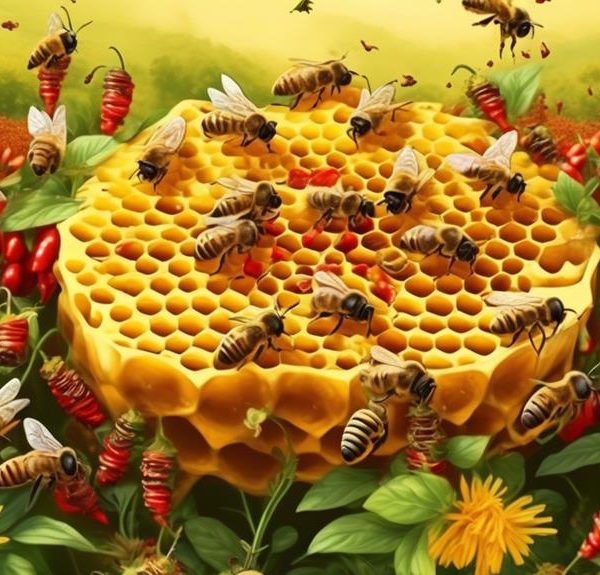Uncover the secret to perfect beeswax tapers by understanding the vital role of wick size in candle-making.
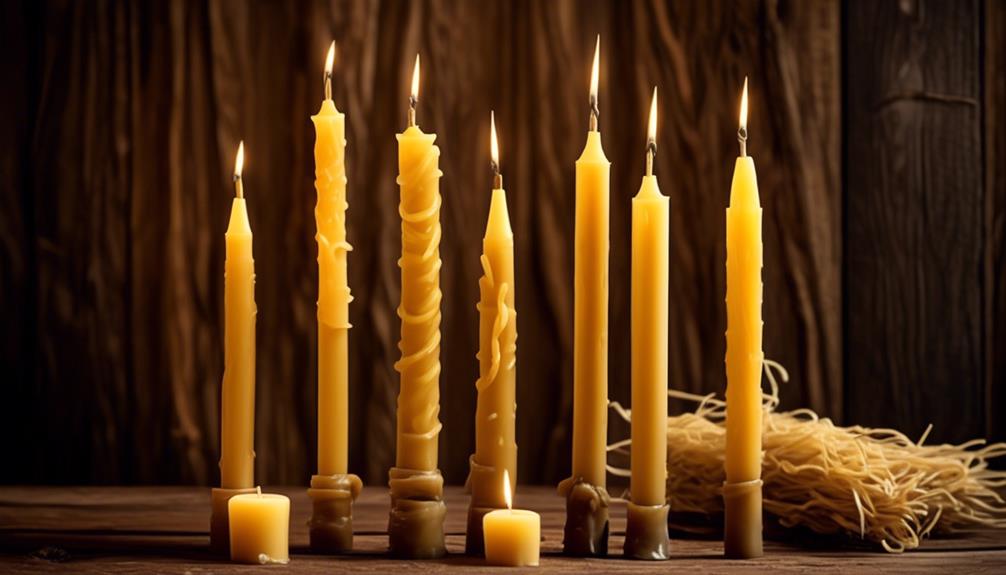
What Size Wick for Beeswax Tapers?
As the old saying goes, 'the devil is in the details,' and when it comes to crafting the perfect beeswax taper, the size of your wick can be one of those devilish details that can truly make or break the outcome. You might think it's as simple as threading a piece of string through wax, but there's a science to it, a methodology that, when understood, can take your candle-making game to a whole new level.
But why does the wick size matter so much and how can you determine the ideal size for your beeswax taper? Let's get into the nitty-gritty of it and you'll discover the significance of this seemingly minute aspect in the larger picture of candle making.
Key Takeaways
- Beeswax taper candles have longer burn times and brighter, steadier light compared to other candles.
- Selecting the correct wick size is vital for the optimal burning experience.
- The thickness of the taper determines the wick size, with thinner tapers requiring smaller wicks and larger tapers requiring bigger wicks.
- Wick size affects the candle's burn time, flame brightness, and smoke production, so finding the right balance is crucial for optimal candle performance and safety.
Understanding Beeswax Taper Candles
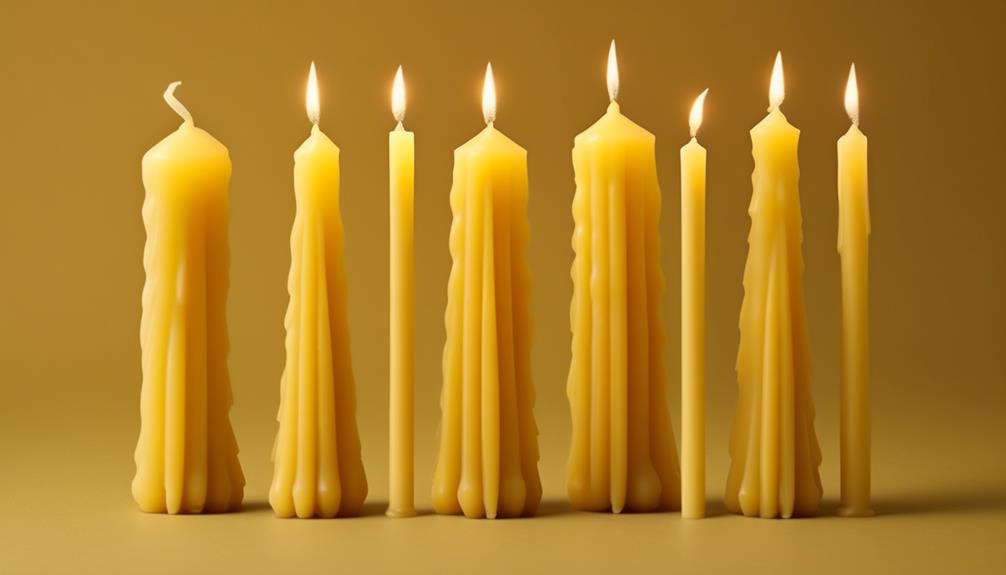
Often, you might find yourself intrigued by the aesthetic appeal and natural aroma of beeswax taper candles, but understanding their unique aspects, such as wick size, is crucial for optimal use and enjoyment. So, let's get to the nitty-gritty.
Beeswax taper candles are a step above the rest, not just because they're pretty but for their longer burn times and brighter, steadier light. But, here's the catch – the wick size plays a significant role in achieving this. If the wick's too small, your candle won't burn properly, wasting the wax. If it's too large, you'll end up with a smoking, sputtering mess.
The standard wick size for a beeswax taper candle is 2/0 square braid wick. It's perfect for candles with diameters of 7/8' to 1'. But remember, it's not a one-size-fits-all scenario. For larger candles, you'd need a larger wick and vice versa. It's all about balance!
In essence, understanding your beeswax taper candles is like knowing the perfect recipe for your favorite dish. With the right ingredients and measures, you're set for a delightful experience. So, don't shy away from understanding the specifics. It'll enhance your beeswax taper candle experience.
Importance of Wick Size Selection
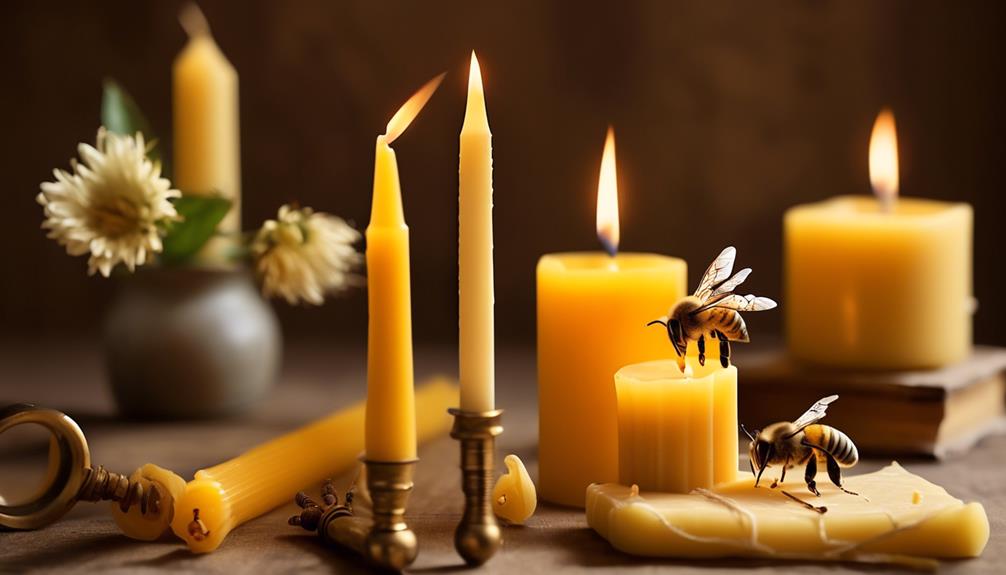
Just as you've grasped the importance of wick size in beeswax taper candles, it's key to understand why selecting the correct wick size is vital for the optimal burning experience. The wick size affects the flame's size, burn time, and even the scent distribution.
Choosing too small a wick and you'll find your candle burning too slowly, not producing enough light, and leaving a tunnel of unused wax around the edge. This is known as tunneling, and it's not only wasteful, but it also shortens the lifespan of your candle.
On the other hand, a wick that's too large will burn your candle too fast, produce excessive soot, and might even be a potential fire hazard.
Therefore, for beeswax tapers, it's generally recommended to go for a medium-size wick. This should provide a good balance between the burn rate and light production, without the drawbacks of tunneling or excessive sooting.
Guide to Wick Sizes for Beeswax Tapers
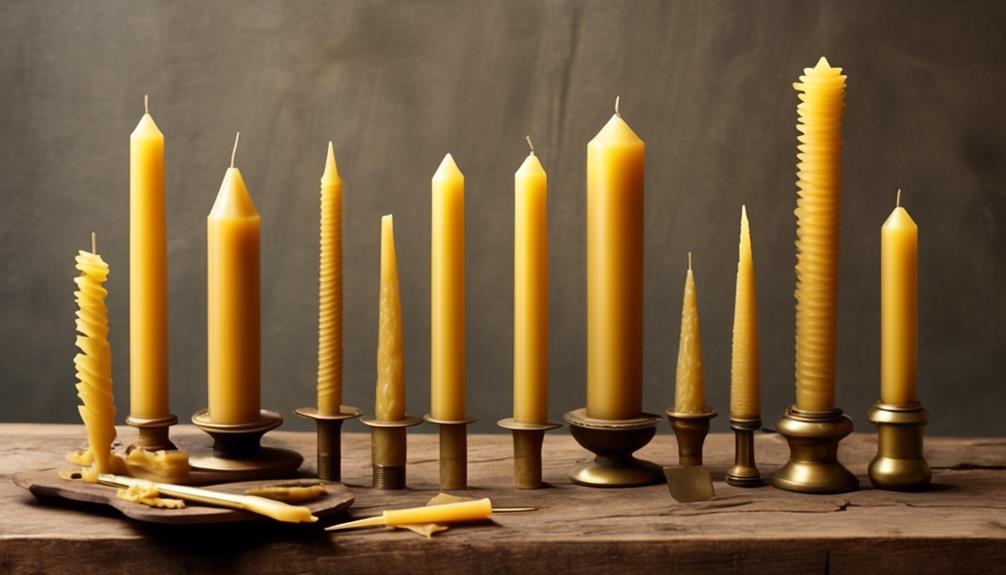
Navigating the wide array of wick sizes for beeswax tapers can be a bit daunting, but don't worry, you're about to get a practical guide that'll make the selection process a breeze.
Firstly, you need to understand that the thickness of the taper determines the wick size. For thinner tapers, around 1/2 inch in diameter, you'll need a small wick, usually #1/0. For medium-sized tapers, around 3/4 inch, a #2 wick will do. Larger tapers, more than an inch in diameter, require a #3 or even a #4 wick.
The length of the taper doesn't affect wick size. It's all about the diameter. Also, keep in mind that beeswax burns more slowly than other waxes, so a slightly larger wick can often yield a better burn.
Lastly, don't forget to trim your wick to about 1/4 inch before lighting for the best results. You'll find that different brands may vary slightly, so it's always best to test a few wicks to see what works best with your specific beeswax tapers.
With this guide, you're well on your way to creating beautifully burning beeswax tapers.
Impact of Wick Size on Candle Performance
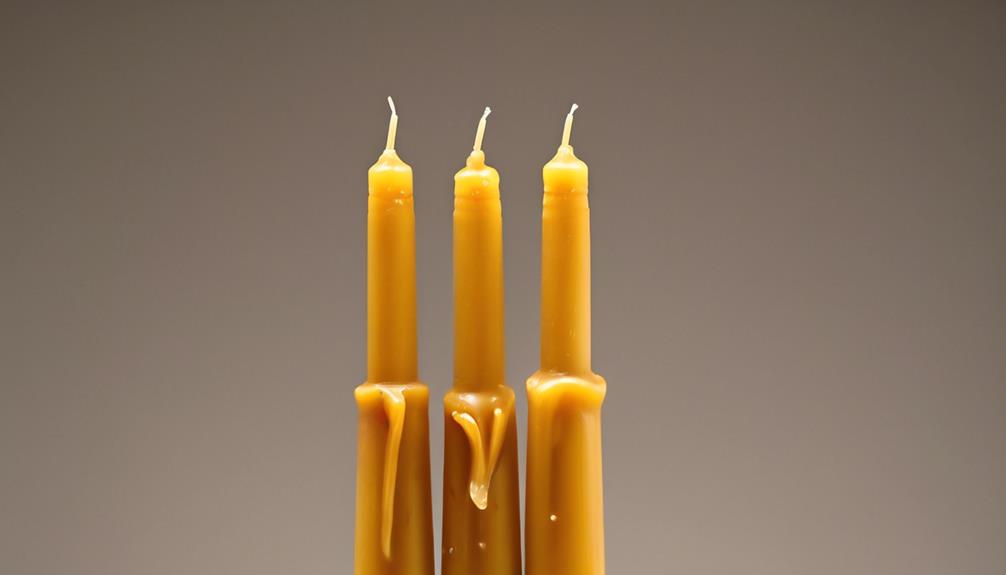
While you've now got a handle on selecting the right wick size for your beeswax tapers, it's equally important to understand how this choice directly influences the performance of your candle.
The wick size determines how much beeswax the flame consumes per hour, thus dictating the candle's burn time. Large wicks allow more wax to travel up to the flame, causing the candle to burn faster. Conversely, a small wick means slower burn times, but it mightn't generate a flame large or hot enough to evenly melt the wax, leading to tunneling.
Moreover, your wick size impacts the brightness of the flame. A small wick produces a dimmer light while a larger one burns brighter. But remember, a flame too large can be a safety hazard, so balance is key.
Lastly, wick size affects the amount of smoke and soot your candle produces. Larger wicks often generate more smoke and soot, which isn't ideal for indoor use.
Practical Tips for Wick Sizing
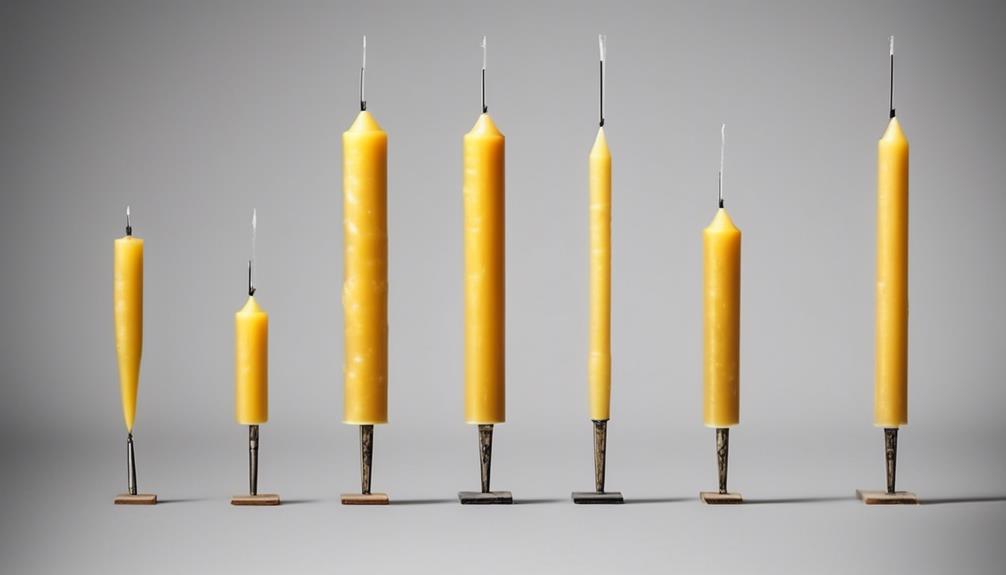
In light of these factors, it's crucial to consider practical tips for wick sizing to ensure your beeswax candle burns safely, efficiently, and beautifully.
Start by measuring your candle's diameter. The diameter typically dictates the wick size. For instance, if your taper has a diameter of 1 inch, a medium-sized wick is ideal.
It's also important to test the wick. Light it and observe. If it burns too fast, leaving a large, flickering flame and a lot of smoke, it's too large. If it produces a small, struggling flame that drowns in the wax, it's too small. The perfect wick will produce a bright, steady flame that doesn't produce excessive smoke or mushrooming.
Remember, beeswax is denser than other waxes. You'll likely need a larger wick than you'd use for a paraffin candle of the same size. Also, keep in mind that braided or knitted wicks tend to burn slower and last longer.
Lastly, patience is key. Wick sizing can be a trial-and-error process. It might take a few tries to find the perfect wick for your beeswax taper. But with practice, you'll become adept at choosing the right wick size.
Frequently Asked Questions
How Does the Color of Beeswax Affect the Burning Process of Tapers?
The color of beeswax doesn't significantly impact the burning process of tapers. Whether it's white or yellow beeswax, you'll see a clean, steady burn. However, impurities can affect the quality of the burn.
Does the Scent of Beeswax Candles Change With Different Wick Sizes?
No, the scent of your beeswax candles doesn't change with different wick sizes. What changes is the burning rate and brightness.
Larger wicks burn hotter and faster, producing a brighter flame. Smaller wicks burn slower and less bright.
However, regardless of the wick's size, you'll still enjoy the natural, sweet, honey-like fragrance that beeswax candles are famed for.
Are There Any Safety Precautions to Consider When Selecting a Wick Size?
When selecting a wick size, safety is crucial. You should ensure the flame isn't too large to prevent wax from dripping or the candle from smoking excessively. A small wick could drown in the wax, causing the candle to go out unexpectedly.
Always trim your wick to ¼ inch before lighting and never leave a burning candle unattended. Remember, safety first when you're dealing with open flames.
How Can I Store Beeswax Tapers to Maintain Their Quality Over Time?
To store your beeswax tapers properly, you'll need a cool, dry place. Avoid exposing them to heat or sunlight, which can cause warping and discoloration. Don't wrap them in plastic, as this can trap moisture and ruin the wax. Instead, use acid-free tissue paper for wrapping.
Can the Type of Wick Material Influence the Burning of a Beeswax Taper?
Absolutely, the type of wick can greatly influence how your beeswax taper burns. Cotton wicks are a great choice as they burn cleanly and evenly.
If you're using a larger taper, you'll want to go with a thicker wick.
Conclusion
Choosing the right wick size for your beeswax taper candles is crucial for optimal performance. It affects the burning time, flame size, and overall candle experience.
As a rule of thumb, a #1 square braided wick is generally suitable for beeswax tapers. However, don't be afraid to experiment with different wick sizes until you find what works best for your candles.
Remember, proper wick sizing promises a cleaner, longer, and more enjoyable burn.


